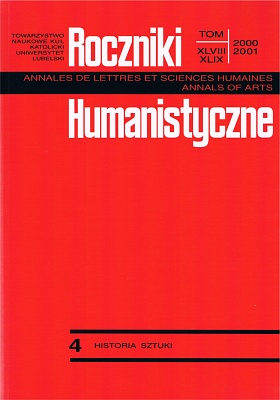Miasto w pejzażu malarstwa niderlandzkiego. Topika i obrazowanie
Abstrakt
The concept of town in the Middle Ages and its image in art have two vectors: sacred and lay. In the early medieval painting the meaning of the sacred town dominated, whereas along with the development of towns in the 13th century the town as a real urban and architectonic space gains its place in an ever more distinct shape. The beginnings of this process are shown in miniature painting that was originated in Paris studios, starting with Louis the Saint's Psalter. They are selected details of the town architecture, e.g. the Notre Dame Cathedral in Paris, and places that were important for the city, like the Seine, that constituted scenes of action that had a sacred character.
The end of the 14th century, and especially illuminations by Master Marshal Boucikaut are an example of developed town structures submerged in a landscape reminding of native ones. Miniature painting of the turn of the 14th century is a preparation for the Dutch tabular painting of the 15th century with its mature town structures along with the adjacent area joined with the town by means of roads and moving people. These landscapes are not autonomous views of towns but they remain the place or background for narrative scenes, mostly sacred ones.
In their multitude and variety the compositions make one undertake an attempt to work out their typology; hence the following composition groups have been identified:
1.Events presented indoors within a town
Rooms situated on the level of the landscape surrounding them
Rooms situated considerably higher than the landscape that can be seen
2.Events in an open landscape with the town
Events situated at the walls of the town
Events situated in suburban areas with a perspective of the distant town
3. Selected motifs as substitutes for the town
4. A real town uniting all the visions of the holy town
The presented types of towns joined with sacred scenes on selected examples of Dutch painting put the question concerning the degree to which they are real as compared to the real towns as well as their symbolism that was expressed in the oriental or archaic architecture. The situation of towns in the Netherlands in the 15th century after the Hundred Years' War shows a developmental dynamics in its industry and social life. Owing to historical research tendencies may be recognised for combining small town structures into big organisms in order to strengthen their economic standing. This is shown in Jan van Eyck's and Roger van der Weyden's paintings. At the same time a significant role of the nobility can be noticed along with its life outside the town that is marked in the paintings by feudal type castles or suburban residences. The end of the 15th century brings limited visions of towns, as selected architectonic forms take over, which are substitutes for the town and point to a departure from painting whole urban structures.
Copyright (c) 2001 Roczniki Humanistyczne

Utwór dostępny jest na licencji Creative Commons Uznanie autorstwa – Użycie niekomercyjne – Bez utworów zależnych 4.0 Międzynarodowe.





